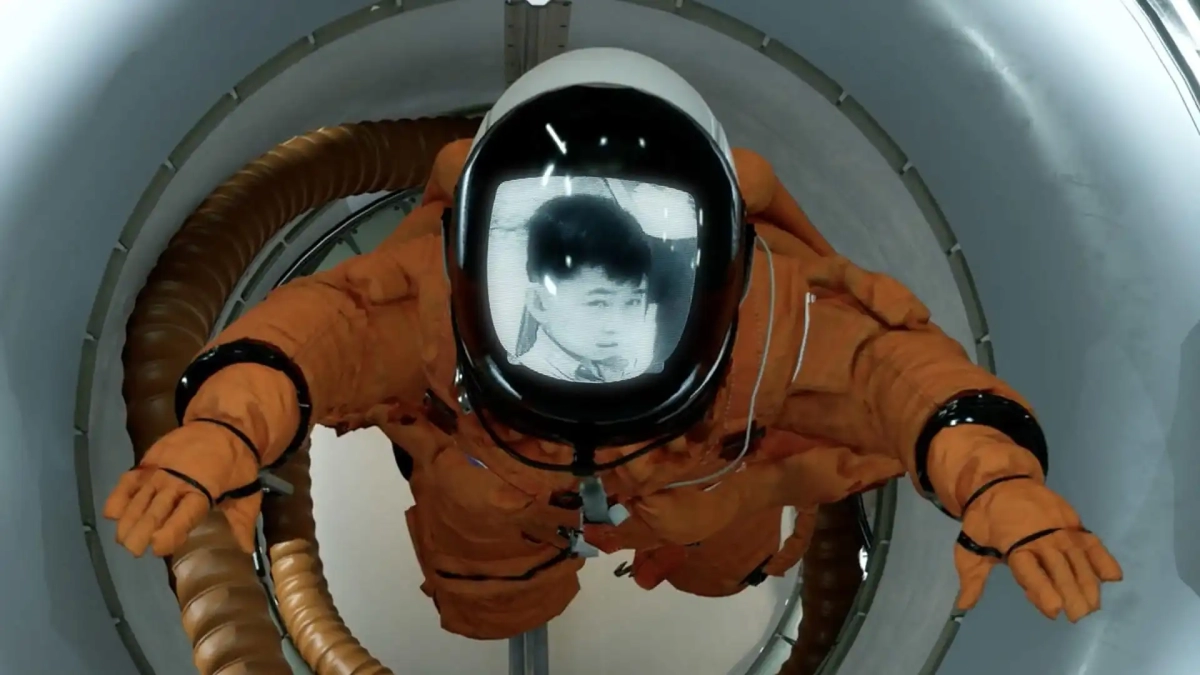An Interview with the Creator of “Attack, Decay, Release”
H.P. Mendoza’s musical triumph, “Attack, Decay, Release,” is not just a movie. It is a family get-together with the strangers you experience it with. Created by a Filipino director based in San Francisco, this 93 minute long adventure through the history of humanity was commissioned by The Svane Project as a part of their “Ark” series, where they asked several artists from varying disciplines to give their interpretation of carrying all of humanity to a better place. Mendoza’s response to this prompt was a revolutionary three-screen dance party that follows an astronaut as they grapple with whether earth and humanity are worth saving. I spoke to Mendoza on the 28th of July, 24 hours before he performed his piece to a packed audience at The Asian American International Film Festival.
So how did you get your start in film?
I think it’s a loaded question. Because like, there’s the academic answer, right? Like where I first went to school, but my start in film was probably when my father bought me a Super 8. I would use that camera to basically shoot all my stuff to animals. And I was always recreating “The Wizard of Oz.” So I wasn’t even being original, until I decided to take the Super 8 camera, and I would film it as if it were a car racing along my Hot Wheels track. And then I’d project that three minute reel in the living room and I would make my family sit down on the couch. When it’s playing, I would move the couch back and forth pretending that we were at Universal Studios, like we’re on a motion ride. So it wasn’t even like a movie that I made. It was more like I tried to make an amusement park ride first. I wanna literally move people.

Would you say that experience with immersing people with movement inspired the format for “Attack, Decay, Release”?
I think so. I was aping a lot of those experiences you’d find at Disneyland. Sure. And I might be dating myself, but one of my mom’s favorite experiences at Disneyland was, like, “Frontiers of America” or something like that. And there were screens that went all the way around you. But they weren’t perfect, and I thought that was kind of cool. Now we have things like “Star Tours” and everything at Disneyland, but at the time they just had a bunch of screens around you and it was called Circle-Vision. I always had a thing for three screens.
What were your initial thoughts when you were approached by Svane Foundation for this project?
Interestingly, when I was approached, my first thought was, “Oh, people are doing things?” Because this was in the middle of the pandemic And I remember thinking, “Well, what a boon.” I’d never been commissioned to do an art piece before. I’ve only been given budgets – like, if you go and you talk to executive producers and investors saying, “I wanna make a movie.” And you may or may not get that money, but when you do get the money, you better put that to good use. Art commissions are different. I think especially during the pandemic, The Svane Foundation wanted to give money to artists so they could subsist and exist. And they were giving $10,000 to a hundred artists to reinterpret Noah’s Arc.
They were being kind of cool and old school about the way we deliver the art, where they made people show up in person, which felt kind of revolutionary at the time. It’s like, “Oh my God, we’re all gonna be masked. We’re gonna see people.” And we all got to this one space, and I saw all these artists that I recognized, and they were luminaries, artists that I’ve known or admired for years, if not decades. I was all masked up, but I could tell by their art who they were. And I was like, “Oh, what am I doing here?”
That’s really cool. And you had a pretty small team for this project, all things considered.
It was me. [Laughter]

You and a couple other people. I read the credits.
People overseas. There were some people that I actually met online when I couldn’t do all of the animation, because you can’t do everything yourself. My husband and I do very basic slash corporate animations. That’s how we make money. We don’t make money making movies, you know? I think I’d hit my cap at some point, and I thought to myself, “Well, this better be good if this can be exhibited as a piece of art for a month. Um, I need to make sure that this feels worth the entry fee.” And so I started commissioning people from overseas saying, “Hey, I like your art. Would you mind maybe tweaking some of what you do for my piece?” But other than that, for the most part, the people who star in the movie are me and my husband and I got Anna Ishida from “I Am a Ghost” to do some vocals, and Carolyn Olis who did the theme song for “I Am a Ghost” to do a number on this.
So you had a really small budget and practically just a crew of you, and your husband?
I can’t really say that my husband was part of the crew because I didn’t want him to know about it. I wanted him to know something was happening, but I didn’t want him to be privy to what the story was about. I wanted to surprise him, so I took my office in my small San Francisco apartment and coated the walls with green made a green screen studio. hen the time was right, I’d be like, “Hey, ark, get in here. Put on your astronaut outfit. Now,I need you to be dead,” or “I need you to be looking depressed.” So I really only used him for, like, a day and he still didn’t know what was going on, and he liked it that way. or the most part, I locked myself away in there and I was communicating via Zoom with Bill Lao and some other people who were in Eastern Europe. They were the animators. A friend of mine helped make the model arc ships that you see flying. So I have those sitting at my desk right now. This was as DIY as anything I’d ever done before.
You used a lot of footage courtesy of The Prelinger Foundation. Why did you choose to work with them?
I was never not going to use historical archival footage. And Rick Pinger and Megan Pinger, they’re luminaries in San Francisco because they have this show called “Lost Landscape” where they show a lot of this lost historical footageI love finding old footage.When you see the modern day, footage of protests, that’s mine. And all the Tokyo stuff is stuff I shot while I was in Japan when the pandemic hit. So I thought to myself, “How cool would it be if we started with historical footage that showed like, let’s say the rise of Hitler, Ford creating cars, he Industrial Revolution, or even educational films about the Civil War that lead all the way up to the stuff that I shot?”
You were born in San Francisco and have a Filipino heritage. How did your background influence the film? Or did it at all?
I would challenge any creator who is Filipino or is of Filipino descent to tell me that they aren’t influenced by our culture.The first film that I wrote and starred in was this film called “Colma: The Musical” That premiered here at AAIFF. And I remember thinking “Well, this isn’t really a Filipino film.” And everyone was like, “It’s got a lot of Filipinos in it.” Because that’s what I know. If I didn’t make it, it wouldn’t have those things in it. It’s very much from the lens of being Filipino American and coming out to your immigrant Filipino father.
Do you have any final words for the readers at home?
One thing I’ve been talking about a lot is my Imposter Syndrome. I have Imposter Syndrome real bad. And I think a lot of people are like “Oh, you’ll grow out of that.”A lot of people who aren’t artists will tell artists that they need to grow a thicker skin. And it’s funny, because I think to myself, “This is advice coming from people who just want more art.” They don’t know what it takes to make the art. They don’t know that it takes Imposter Syndrome to try to better themselves every time. It takes a lot out of all of us, and I come to festivals like AAIFF, and I meet a lot of other filmmakers, and we all look like we have a little bit of PTSD. We indulge and laugh at it, but it’s real. It’s not the same as having some sales rep representing our films. We are traveling with these things and trying to give the best show possible, because a lot of us don’t believe we deserve to be here. So if you show up to our stuff, seriously, thank you, because when you show up, that’s the reminder that we have to keep on going.
“Attack, Decay, Release” screened at the 46th Asian American International Film Festival.

